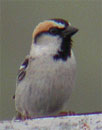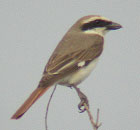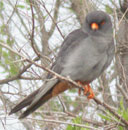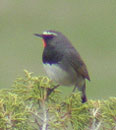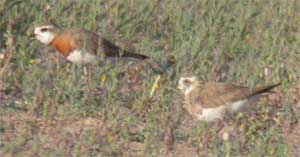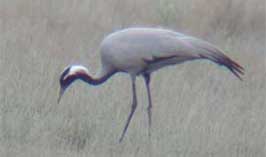INTRODUCTION
Kazakhstan has become quite a popular world-birding destination as it holds a fine selection of Western Palaearctic rarities and Himalayan specialities. Uzbekistan is better known to the travelling tourist for its historical links with the old Silk Road and the spectacular buildings in towns such as Samarkand and Bukhara. To the birder its main attraction is
Pander's Ground-Jay, although it does hold a few other species not so readily seen in Kazakhstan. Both countries gained independence in 1991 with the break-up of the USSR and are fairly easy to visit with the help of local agents. They appear to be safe and have been largely unaffected by terrorism or extremism.
DPA, NB and JH decided to visit both countries and were joined by AD and RAF in Kazakhstan. We were later than most tours, with the result that we missed most of the passage migrants but found many species with nests or young. The trip was both enjoyable and successful, seeing almost all the specialities, including
Himalayan Snowcock, Macqueen's Bustard, Caspian and S
ociable Plovers, Ibisbill, Yellow-eyed Stock Dove, White-winged and
Black Larks, Eversmann's and
Guldenstadt's Redstarts, Azure and
Yellow-breasted Tits, and
Pander's Ground-Jay. We did not go for Relict Gull as it would have entailed at least an additional long day of driving to a lake, and another day back, with its presence was not guaranteed.
 LOGISTICS
LOGISTICS
Kazakhstan is toured by several companies, ranging from the relatively cheap Naturetrek and Birdfinders to the top-of-the-range Birdquest. Sunbird is the only company to offer a tour to both countries; Steve Rooke was kind enough to invite us to join the search for the ground-jay from Bukhara and so we can vouch for the excellence of this tour, done with style and comraderie. Joining one of these tours is certainly the easiest way of visiting the region.
In order to obtain visas, it is a requirement to have a letter of introduction, eg from a tour company (although this is no longer necessary for Kazakhstan). There are 3 or 4 companies in Kazakhstan that can arrange birding tours and provide the letters as part of the package. We booked a full tour with Intourist-Akmola Ltd, based in Astana, and they sub-contracted the Almaty part to Tarpan Tours, so in retrospect it might have been better to have booked direct with the latter, although both companies clearly worked well together. As well as providing all the accommodation, transport, food and soft drinks, they also obtained the permits necessary to visit certain areas, so that our only extra expenditure was beer for those sad souls unable to survive a few days without it.
For the Uzbekistan visa, we contacted Zak, the agent kindly recommended by Steve, and he sent the requisite letter of invitation. He also arranged accommodation and taxis for us, all for the princely sum of $30 a head (excluding the cost of hotels and cars) - an excellent service. Hence, apart from the considerable extra expense of the flights, this part of the trip was cheap and worked very well.
TRANSPORT
AD and RAF flew to Almaty via Frankfurt, with Lufthansa who were offering a very good deal from regional airports. Tickets were booked through Dial-a-Flight who gave a good and competitive service. The only airlines flying to both countries were Uzbekistan Airways and Turkish Airlines; we elected to use the former as they flew direct from Heathrow to Tashkent, and from there to Almaty. Hence our ticket was London-Tashkent-Almaty-Tashkent-London, plus an internal flight to Bukhara, the gateway to the ground-jay. After boarding we discovered the outward flight stopped first at Samarkand and so it would have been possible to have disembarked there and taken a taxi to Bukhara. The flights were booked direct with Uzbekistan Airways, 0207 935 1899, who provided a good service. We were surprised to find most of the passengers were Sikhs on their way to Amritsar, as UA have connecting flights direct to this Indian destination. One passenger at least had a very cheap ticket, purchased through Jas Travels 0208 574 1133.
We all took a return internal flight from Almaty to Astana (to see the larks), booked through our Kazak agents.
All ground travel was arranged by the efficient agents, mainly in relatively cheap taxis in Uzbekistan, that gave no troubles, and agency mini-buses in Kazakhstan.
ACCOMMODATION, FOOD and COST
We mostly stayed in basic to good hotels and lodges, but camped comfortably in a yurt for 2 days in the Taukum Desert. The hotels in Uzbekistan, which were all good, cost $15-25 a night for single rooms, b & b.
Main meals were good, especially in Uzbekistan, and beer much cheaper than at home. Picnic lunches, with plenty of food on offer, were the norm in Kazakhstan, though sometimes well past normal lunchtime!
In both coutries US dollars were readily accepted. For small value items we exchanged dollars at our first hotel, at a rate of 1100 Uzbeki sum to the dollar. In Kazakhstan we changed a few dollars at an Almaty bank, receiving 150 Kazakh tengge/$. ATMs were used by JH in both counties, the only difficulty being finding them.
VISAS
Required for both countries, application forms obtainable from Embassies in London or websites, returned in a couple of days. The cost for single entry visas was £23 for Kaz and £26 for Uzbek.
MISCELLANEOUS
We had no security or health problems. Some of the party took malaria prophylactics but others did not. Police/ military were in evidence, especially on the main roads, but were not intrusive. English was not widely spoken except in the tourist centres in Uzbekistan. Everyone appeared friendly.
The weather was quite good and pleasantly hot, except in the mountains, but it did rain at length on several days, especially around Astana where it was mostly cool and wet, a common phenomenon apparently. It can be very hot in the desert from June onwards.
Internet facilities are available in major towns but are not common.
Note Uzbekistan is 4 hours ahead of us and Kazakhstan 6 hours.
REFERENCES
Flint, V.E. et al, (1984) A field guide to the birds of the USSR. Princeton.
Kazmierczak, K & van Perlo, B. (2000) A field guide to the birds of the Indian Subcontinent. Pica Press.
Grimmett, R., Inskipp, C. & T. (1998) Birds of the Indian Subcontinent. Helm.
Useful to take a European fieldguide too and possibly monographs on warblers and shrikes.
There are several trip reports on the net but all seem to be from organised tours giving no details of sites or arrangements.
RECOMMENDED TRAVEL AGENCIES
Zak at Olympic Tour
olimptur@globalnet.uz . Highly recommended for Uzbekistan.
Vassiliy and Natasha at Tarpan Tours
eskova_natasha@softhome.net or
natalya_eskova@mail.ru or
snowleopard_kz@hotmail.com tel/fax 007 3272 532419, 32 Samal-1, Off. 11, Almaty 480099, Kazakhstan. Highly recommended for Kazakhstan - also organize Snow Leopard tours, one of which was successful for Richard Webb.
Maryana and Larisa at Intourist-Akmola Ltd hocmun@mail.kz
ACKNOWLEDGEMENTS
We are very grateful for the assistance given by Maryana and Larisa, Zak Toshnazarov, Vassiliy and Natasha Yeskov, Dorrie Andrew, Vaughan Ashby and Svetlana Annenkova, Dave Farrow, Steve Rooke, Chris Steeman, and John Tomkins and friends. The photos here are © Andy Deighton.
ITINERARY
May
24th 15.30 flight from Heathrow to Tashkent.
25th Arrived Tashkent, flew to Bukhara, city tour.
26th Day trip to desert for Ground-Jay.
27th Morning trip to Amu Bukhara Canal and Tadgkul Lake; taxi to Samarkand.
28th Early birding at Zarafshan; tour of historic Samarkand, taxi to Tashkent.
29th Day trip to Chimgan Hills.
30th Morning tour of Tashkent. Flight to Almaty from Tashkent or Birmingham.
31st Drive to Taukum Desert with stop at Tamgaly Tas petroglyphs. Camp near Kanshengel.
June
1st Day trip to Ili River delta.
2nd Drive to Tien Shan mountains with stops at Sorbalak Lake and Almaty. Night at Obs.
3rd Day in the mountains.
4th Drive to Charyn River with stop below Kokpek Pass. Night at Ash Tree Grove.
5th Day in Ili River Valley.
6th Day in Charyn River Valley including Red Canyon and Sogety Valley.
7th Charyn River, Sogety Valley, then drive to Almaty with stop below Kokpek Pass. Flight to Astana.
8th Day in grasslands and lakes including Lake Sholak.
9th Day in wetlands near Astana, evening flight to Almaty.
10th Flights to London via Tashkent or Birmingham via Frankfurt.
SITES
As the Kazakhstan agents know where all the sites are, only a few details are given here.
THE ILI DELTA
We belatedly discovered that we just failed to reach the best area here. Turn right shortly after passing Topar village and drive for 28 km (possibly more) to the village of Zheltorhangy, with a Muslim cemetery on the left. Beyond here is Saxaul and Turanga that hold all the specialities;
Eversmann`s Stock-dove is said to be particularly numerous and can be seen perched along the roadside wires. We were told that the reeds on the way, eg at the lake with a Black-headed Gull colony, hold Black-headed Penduline-Tit, a bird we did not see (other than a probable by NB in the Ili Valley).
HOT SPRINGS, ILI RIVER
Turn off to the left before the Ili River bridge on a poor easterly road going from Charyn to Borandasu. It took about an hour to drive to the hot springs resort, that looked like a collection of large buildings next to marshes, scrub and pools. Many
sandgrouse, including some
Pallas', were to the south of the road c.1km before the resort. Both species flew to the pools to drink,
Eversmann`s Stock-doves flew past, and the scrub near the pools held
Rufous Bushchat.
WHITE-THROATED ROBIN SITE
This was on the way back to Almaty from Charyn. After crossing the Kokpek pass there are 2 restaurants on the way down on the left and some concrete "boxes" in between them on the right. Just before the boxes a track goes up a narrow gorge on the right through thorny scrub, about 5km before the lower restaurant, supposedly a site for white-throated
Pied Wheatear. The robins were about halfway up the gorge, along with both
rock-thrushes and
White-capped Bunting.
At Astana, as long as you have Alexander Pivovarov (
tanechkasl83@mail.ru or @yahoo.com ) as guide, there should be no difficulty in finding all the birds to be seen.
In Uzbekistan, the only important sites if going to Kaz are the whereabouts of the
Ground-Jay and the Chimgan Hills. To see the former, proceed along the main Bukhara to Khiva road for some 200 km and then look out for them perched atop the small bushes.
Desert Warbler and
Scrub Warbler are here too. The Chimgan Hills are well-known in Tashkent as a skiing area in winter and a walking area in the summer. Go to the main tourist complex and walk up the hill to the left where the first ski-lift is;
Yellow-breasted Tit should be here. Another km or so, the quarry on the left near the pass is a site for Eastern Rock Nuthatch, though we could not find it, ditto Rufous-naped Tit which should be in the conifers.
DAILY LOG
25th May DPA, NB & JH reached Tashkent at 04.00 and flew on to Bukhara at 09.30, arriving at 11.00. We were met by Shaknoza, the hotel owner's daughter, and driven to the Nazira-Azizbek Private Hotel where we were welcomed with fruit, nuts and tea. After lunch there, we spent the afternoon with Shaknoza on an interesting sightseeing tour of the ancient buildings, somewhat marred for JH by his Nikon camera dying. After a good dinner of plov (lamb, carrot and fried rice), Steve Rooke and Zak, his local agent, came round and gave us useful information.
26th May We joined the friendly Sunbird group at 05.30 and drove in a modern coach along the road to Khiva. 200 km later we stopped at a small farm, an oasis in the desert. This was alive with migrants including c.15
Golden Orioles, Clamorous and
Great Reed Warblers, Spotted Flycatcher and, most surprisingly, 2 Crossbills! After a good breakfast, we drove a bit further and espied a
Pander's Ground-Jay, the day's main objective. We feasted ourselves for some time on a group of 5 and a few singles, feeding rapidly, possibly on ants; the only other birds were Scrub and Desert Warblers and Crested Lark. We returned to the oasis for more birding and an excellent lunch, then back to Bukhara at 3.30 p.m. for more site-seeing and carpet-shopping.
27th May After breakfast we took a pre-arranged taxi to Amu Bukhara Canal and drove along the canal to a view-point over the nearby WWF reserve where Przewalski's Horse and Goitered Gazelle could be seen. Blue-cheeked Bee-eaters and Nightingales were numerous and a single Menetries Warbler spotted. Then we went to the vast Tadgkul Lake and tried unsuccessfully to find the area where Sunbird had seen Marbled Duck. We did see
Pygmy Cormorant, White-tailed Plover, Sykes' Warbler and several other ducks and terns, before leaving at 12.30 for the hour's drive back to the hotel. After lunch we took another car to Samarkand, 2.30-6.0 p.m., and stayed at Muhandi's B & B, a delightful spot in the old town. After a walk in the old town, a huge dinner was enjoyed at Muhandi's, with cheap beer.
28th May At 06.00 we taxied to the wetland area of Zarafshan, 6 km outside the city, where birds included
White-winged Woodpecker, White-capped Penduline-Tit, Turkestan Tit and many
Blyth's Reed-warblers. We returned to Muhandi's for breakfast at 09.15, then took a 4 hour tour of the spectacular historical sites with Aziza, the joint-owner of the hotel and an excellent guide. Numerous
Alpine Swifts were nesting in the old buildings and we rescued one grounded bird, which took-off safely after being thrown into the air. At 4.20 p.m., we departed for the 4 hour drive to Tashkent, a longer trip than normal because the shorter route through Kazakhstan was closed due to the Sars epidemic;
Egyptian and
Eurasian Griffon Vultures were seen on the way. We stayed at the good Hotel Maliko, kindly booked for us by Zak.
29th May We spent a rainy day in the Chimgan Hills, departing by taxi at 06.00. After driving for 2 hours to the Tourist Complex, a ski resort, we walked a short distance up the hill by the first ski lift. We soon saw Yellow-breasted Tit, the main objective, along with
Hume's Lesser Whitethroat and
Blue Whistling-Thrush. Continuing a further km to the pass, we found singing
White-capped and
Rock Buntings, then spent some time exploring quarries and rock-faces for Eastern Rock Nuthatch, but only seeing Pied Wheatear of note. On the way down, we stopped for
Booted Eagle and
Isabelline Shrike, then kebabs and bread, before reaching the hotel at 4 p.m. Zak came round with the defective camera, which he had managed to get repaired by a friend, much to JH's relief. Later on NB and JH went into town to explore the lively Boulevard.
30th May After a bit of a lie-in JH visited the main sites (not up to Samarkand/ Buhkara standards), by foot and metro while DPA and NB relaxed at the hotel. We took a taxi to the airport at 1.30 p.m. and flew to Almaty, arriving at 7.30 (Kazakhstan time is 2 hours on from Uzbekistan). We were met by Vassiliy and Natasha and taken to the Hotel Saya for a good night's rest.
31st May AD and RAF, who had arrived at the Hotel Saya in Almaty around midnight, met up with DPA, NB and JH at breakfast. There was time for a short walk around a nearby park before departure for the Taukum Desert at around 09.00. Our team was Vassiliy in the support vehicle, Denis the driver, Natasha the interpreter and Altyn the ecologist. After leaving the extensive suburbs we travelled through farmland and then increasingly arid steppe, with the Tien Shan mountains always in view to the south, to reach our yurts in the artemesia-dominated desert 2km westwards from Kan Tengri camp, near Kanshengel, at 19.15. We had stopped en route at the famous Bronze Age petroglyphs at Tamgaly Tas but sadly no Eastern Rock Nuthatches were still breeding here. From our yurt we could see displaying
Macqueen`s Bustards and a
Caspian Plover. After our evening meal we had a pleasant hour`s walk in the desert to end the day.
1st June Fortified by a wake-up cup of tea, we were out in the half light to a small pool by a well but no sandgrouse arrived. After breakfast and
Greater Sandplovers we were off for a day in the desert and the Ili River delta, where there are numerous lakes in the sand dunes. We easily found three of our principal targets,
Azure Tit, White-winged Woodpecker and
Saxaul Sparrow, the latter two at nests, but only DPA and AD saw Eversmann`s Stock-dove, in a small Turanga wood. It rained while we were here but the evening was sunny. Back near Kanshengel an area of trees and bushes around a stockade was alive with warblers and other migrants. Nearer the yurt we watched mating
Caspian Plovers and a family of
Demoiselle Cranes before making contact with a group of Spanish ringers at the pool where we had begun the day. Vassiliy put on a special `Welcome to Kazakhstan` evening meal with copious vodka and gave us all a hat of the local style.
2nd June We went for a short drive in the desert before leaving our yurts at 08.30 for the return to Almaty, this time on a more easterly route across steppes ablaze with poppies. Our only lengthy stop was at Sorbalak Lake to photograph the large
Rose-coloured Starling colony. We were back in the city by early afternoon but did not linger, heading into the Tien Shan Mountains where we had our picnic lunch a little way inside the park boundary. We climbed steadily through coniferous forests and meadows, seeing new species at every stop.
Ibisbills were found quite easily on the braided river flowing into the scenic reservoir below the astronomical observatory. We arrived at the latter at 20.00, JH renewing acquaintance with John Tomkins who had been on the Peru Naturetrek trip in March: as his group had been here for a few days they were able to give us valuable information.
3rd June We were reasonably lucky on our only full day in the Tien Shan in that the weather was beautiful until mid-afternoon when it clouded over with rain around teatime. After initial wanders in the vicinity of the observatory, our bus took us to the radar station at the upper limit of the road, where we found most of our targets easily. Here NB disappeared along a distant ridge, AD disappeared into a deep snowdrift and JH just disappeared. Eventually four of us walked most of the 6km back along the road towards our base, before being picked up by our bus. It contained a triumphant NB, who had obtained good views of a
Himalayan Snowcock. After lunch and some more local birding we tried another known Snowcock site beyond the reservoir in vain. After more birding around the obs. in mist and rain we turned in, hoping for better luck tomorrow with the Snowcock.
4th June We were out into the rain just after 06.00, walking up a slope from where a very distant
Snowcock was sighted. Our bus was summoned and took us a few bends of the road higher, to a spot from which reasonable `scope views of two birds were obtained, and our only
Brandt`s Mountain Finch was a bonus. At 11.00 we left the observatory, where we had met Vaughan Ashby (of Birdfinders) and partner. We made various stops and strolls on the descent, and really only Three-toed Woodpecker and White-throated Dipper had eluded us. In Almaty we re-met Vassiliy, who had stayed in the city while we visited the mountains, and then headed east for the Charyn River, stopping for a late [17.30] lunch in a scrubby area. We found
White-capped Penduline-Tit here and White-capped Bunting in a rocky valley below the Kokpek Pass. We emerged from the pass onto a stark, desert plateau ringed by hills, and finally arrived at 21.00 at Hunter`s Lodge, part of the Ash Tree Grove complex.
5th June This was a long and very successful day in the field, from 05.40 to 21.50. We drove straight to the Ili River bridge and on to a Turanga wood where we immediately found a pair of
Eversmann`s Stockdoves. They promptly flew off and as we found no more in our walk through the wood, we felt relieved that we had left our hotel when we did. However we later had good views of birds feeding on a roadside verge and even saw some flying over open desert in the evening. We stopped for some time in an area of woodland and scrub where those of us with entomological leanings were able to look at butterflies and dragonflies as well as birds. In the heat of the afternoon we made a 2km loop walk across stony desert and then cooled off by eating our lunch in a culvert under the road. VA's Kazakhstan partner had said that Pallas`s Sandgrouse were harder than normal to find as it had been a wet spring and recommended seeking them at a resort area. The latter was a small complex of scattered dwellings around a hot spring, where three of the group duly saw a lone PS come in to drink. The other two endured hours of purgatory until a few were flushed on an evening desert walk. A Wolf maybe 300m from the bus on the journey back made a very pleasing ending to the day.
6th June Vassiliy said they would take us on a mystery tour, which proved to be very pleasant. We left at 06.10, crossing the Sogety Valley to the spectacular Charyn Red Canyon. After stopping to watch
Mongolian Finch drinking at puddles in the road, we spent some time in a nearby gorge, where a
Long-legged Buzzard fed a snake to its nestlings and
Grey-necked Buntings were common. We drove to the Zhalanash area, with a stop for singing Pine Bunting, where we lunched in a very picturesque setting by the Charyn river, with its
White-bellied Dippers. We then spent some time in the hills of the upper Charyn Valley watching breeding vultures and Golden Eagle and other birds around a large, deep gorge. Returning to an area near Zhalanash, we vainly tried to see Corncrakes, heard earlier, then to the first gorge to find Altyn`s spectacles, before reaching the hotel at a dignified 20.55.
7th June For the first time we were able to wander around Ash Tree Grove before breakfast and subsequent 08.45 departure. A strong wind hampered our walk on the Sogety Valley but we saw
Desert Warbler and nesting
Steppe Grey Shrike. At 10.30 we returned to the Red Canyon road, busy with tourists, it being Saturday, so after another desert walk we set off back for Almaty, stopping to explore a small canyon in the Kokpek Pass. This produced one of the best finds of the trip in the shape of a pair of food-carrying
White-throated Robins, even a tick for Altyn. We lunched in a grassy area further west, just before heavy rain set in for the day. We were at the airport by 17.20 for our 19.00 flight to Astana, nearly 1000km to the NW. We said a temporary farewell to Vassiliy and his team, and hello in Astana, where it was still raining, to Alexander, Maryana and Sergey, who took us to the Sultan Beibars, a comfortable and modern hotel in a modern city, where, to our pleasure, we were given single rooms.
8th June We were out at 07.15 in rain, which had stopped by late morning. We spent the whole day, to 20.00, at the steppes and wetlands to the W/SW of the city. Because of recent rains some of the scheduled sites were inaccessible to our bus, which lacked 4WD. We slithered all over the place on some tracks and at one stage, when we were away birding at Lake Sholak, the bus became stuck at the bottom of a steep bank and had to be pushed out by passing fishermen. Despite all this we were very pleased with what we saw. The two main targets,
Black and
White-winged Larks, were very easy and we enjoyed watching birds like
Sociable Plover and
Black-winged Pratincole on breeding territories, while it was good to see northern migrant waders at some of the saline lakes and a small breeding colony of
Red-footed Falcon.
9th June This was our last day`s birding and once again it rained, quite heavily at times, until the early afternoon when things improved, with warm sunshine by 16.00. We were out by 07.10, initially visiting damp woodland to the east of Astana for
Pine Bunting. We then birded the same road as yesterday, but staying much closer to the city. We looked at warblers by a small lake before lunch on the bus overlooking a lake with feeding
Black and
WWB Terns. We explored these lakes and some sewage lagoons until returning for a final meal to our hotel by 17.00, half an hour later than expected as RAF went walkabout due to a misunderstanding. We took the 20.00 flight back to Almaty, where Vassiliy took us once again to the Hotel Saya.
10th June AD and RAF left in the small hours for their 04.15 flight home via Frankfurt. DPA, NB and JH enjoyed a decent night`s sleep before leaving the hotel at 08.30 and, after a brief stop at an internet cafe, caught the 11.55 flight to Tashkent and from there to Heathrow.
APPENDIX: Kazakhstan's environment according to Lonely planet
Covering 2.7 million sq km (1.05 million sq mi), Kazakstan is the ninth biggest country in the world, about the size of western Europe or half the size of mainland USA, but with a population of only 16.8 million. It borders Russia to the north, the Caspian Sea to the west, Turkmenistan, Uzbekistan and Kyrgyzstan to the south and China to the east. Kazakstan is mainly dry and flat except for its alpine south-east and eastern fringes which lie along the northern edge of the mighty Tien Shan range. Mt Khan Tengri at 6995m (22,950ft), on the Kazakstan-Kyrgyzstan border, is the country's highest point. Lake Balkash in the central east is huge but shallow - the eastern half is salty, the western half fresh. Kazakstan's underground environment contains massive deposits of iron, coal, oil, gas, lead, bismuth, cadmium and thallium (these last three essential in electronics). These and other minerals have drawn hefty, if shady, foreign investment interest to Kazakstan's otherwise unpromising plains.
Back on top of the crust, Kazakstan has been badly ravaged by dodgy Soviet schemes that have poisoned, denuded and drained. The country was set aside for massive wheat production in the 1960s, setting off a train of ecological nightmares. Water from the Syr-Darya and Amu-Darya rivers was diverted for irrigation, causing the Aral Sea, which they fed, to shrink dramatically. The fishing port of Aralsk was left high and dry and became a ghost town; the fish died out from rising salt levels; rains stopped; salt, sand and dust blew in storms for hundreds of km around; birds and animals have fled the river delta. Chemical residues from agriculture have found their way into the rivers and into Kazakstan's drinking water, while the Kazakh steppe has become eroded, arid and salinised from over-cultivation. In case Kazakstan hadn't had enough, Moscow used the area between Semey and Pavlodar as a testing ground for nuclear weapons between 1949 and 1989; around 40 million people have been adversely affected by radiation.
For a full trip list and daily sightings contact me
